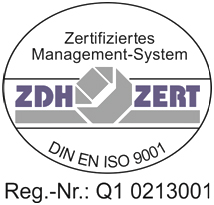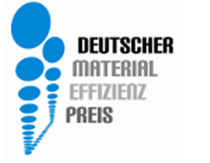Awards

for exemplary achievement PTZWEIDNER received the Innovation Award of the State of Baden-Württemberg 2015
– Dr.-Rudolf-Eberle-Award.
More information!
 We are a certified company and have a certified management system according to DIN EN ISO 9001!
We are a certified company and have a certified management system according to DIN EN ISO 9001!More information!
 in 2010, PTZWEIDNER was awarded the German Material Efficiency Prize by the Federal Ministry of Economy and Technology (BMWi).
in 2010, PTZWEIDNER was awarded the German Material Efficiency Prize by the Federal Ministry of Economy and Technology (BMWi).ALTERNATIVE PATHS FOR COMPANIES
Producing with a green conscience
Material costs are increasingly becoming the largest share of costs in manufacturing operations. Four regional examples demonstrate how companies are taking ownership on behalf of the product. They have tinkered with new technologies, invested into energy-efficient machinery and are recycling waste. And they are demonstrating how resources can be used more efficiently.
The "green conscience" is asserting a prominent role in the consumer's mind: Germans are sorting their waste, transitioning to LED bulbs, and switching off the standby mode. But also for manufacturing companies, financial success and sustainable environmental protection are by now inextricably linked. Material as a share of total costs for manufacturing operations has increased from 40 percent in 2009 to 42.9 percent last year.
But less is more: Less material, reduced energy consumption and shortened cycle times frequently also result in cost savings, as is demonstrated by a success story from Sigmaringen. Metal rings are used in wind turbine plants, trains, aircraft or in mechanical engineering. For decades, production has followed the same basic principle. The rings are cut or sawed under significant heat exposure, and then turned to a defined width - all of which consumes significant energy and materials.
Lord of the rings
After spending 20 years in this business, Andreas Weidner developed a concept that generates significant savings in time, energy and materials when compared to the previous process. He started building a new machine in his basement - piece by piece - each part painstakingly fabricated by hand after hours and on weekends. The innovative process is simple, yet effective: The workpiece and the tool both rotate. In contrast to previous processes, neither thermal energy nor lubricants are added. This allowed Weidner to significantly reduce the energy demand. "Before, it was about 300 degrees, now it is barely 40 degrees", explains the entrepreneur. Compared to using a bandsaw, the processing time is lowered by up to 80 percent, the material consumption by as much as 60 percent. Weidner's machine reduces tool costs by roughly 40 percent due to increased tool life. A chuck initially secures the ring blank; the previously commonly used, wide "cut-off blade" was replaced by a next generation circular saw blade. The rings are cut with such low consumption of material, that only a few small chips are left over that can be reclaimed for further processing. The process works on a broad range of materials, from stainless steel to copper. Weidner was initially confronted with disbelief for many of his rationales: "You will never get the physics to work", was something he heard repeatedly. But Weidner doggedly implemented his idea and taught his critics a new lesson. In 2010, he won the material efficiency prize. Today, about four years after founding his company, PTZ Weidner, he has not only convinced his customers but also his critics.
by Andrea Wieland*
Information |
Primary activitiesCutting, milling, turning and drilling |
Downloads |
PTZWEIDNER © 2013 |